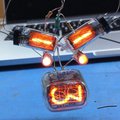 OK folks, time to get the ball rolling. Welcome to the Hack Chat, I'm your moderator Dan, along with Dusan. Today we're pleased to welcome Agustin Cruz to talk about what he's been up to with metal 3D printing,
OK folks, time to get the ball rolling. Welcome to the Hack Chat, I'm your moderator Dan, along with Dusan. Today we're pleased to welcome Agustin Cruz to talk about what he's been up to with metal 3D printing,
I think I saw him log in earlier -- are you out there Agustin?
 Hello everyone
Hello everyone
 Hello and welcome!
Hello and welcome!
 A brief introduction. Dan, please stop me anytime you want.
A brief introduction. Dan, please stop me anytime you want.
 And apologies in advance if I put a "u" in Agustin. Muscle memory...
And apologies in advance if I put a "u" in Agustin. Muscle memory...
 Go for it, I was just going to ask
Go for it, I was just going to ask
 Dont worry. I think Augustine is a girl name
Dont worry. I think Augustine is a girl name
 My name is Agustin. I'm from Chile
My name is Agustin. I'm from Chile
 I have 2 Sinovac and 1 Pfizer vaccine shots in my body
I have 2 Sinovac and 1 Pfizer vaccine shots in my body
 I think this month I will get the second Pfizer
I think this month I will get the second Pfizer
 I'm an electrical engineer with more than 10 years of experience building laser machines, CNC machines, robots, laboratory equipment among other things. For the last 5 years, I'm working on this 3D Metal Printer.
I'm an electrical engineer with more than 10 years of experience building laser machines, CNC machines, robots, laboratory equipment among other things. For the last 5 years, I'm working on this 3D Metal Printer.
 This project consists of an Open source, low-cost 3D Metal Printer for developing and low income countries, using an electron beam to sinter the metal powder
This project consists of an Open source, low-cost 3D Metal Printer for developing and low income countries, using an electron beam to sinter the metal powder
 So, the goal is to make 3D Metal Printing more affordable to the general public, hospitals, small institutions, organizations and companies around the world. Specifically for developing and low income countries.
So, the goal is to make 3D Metal Printing more affordable to the general public, hospitals, small institutions, organizations and companies around the world. Specifically for developing and low income countries.
 Dan, you can stop me anytime
Dan, you can stop me anytime
 This printer uses an electron beam to selectively melt each layer of metal powder, causing the powder particles to fuse together.
This printer uses an electron beam to selectively melt each layer of metal powder, causing the powder particles to fuse together.
 After one layer is complete, the build platform is moved down one layer in height. The re-coater comes in again with a fresh layer of powder, and the electron beam starts to induce the fusion of powder particles, causing the new layer to form.
After one layer is complete, the build platform is moved down one layer in height. The re-coater comes in again with a fresh layer of powder, and the electron beam starts to induce the fusion of powder particles, causing the new layer to form.
 This process is repeated until the entire part is finished, making a solid metal part. Each layer height is around 0.05mm to 0.1mm thickness.
This process is repeated until the entire part is finished, making a solid metal part. Each layer height is around 0.05mm to 0.1mm thickness.
 what kind of X-Y resolution?
what kind of X-Y resolution?

https://hackaday.io/project/183736-3d-metal-printer
3D Metal Printer
Tired of printing plastic? This is the first Open Source 3D Metal Printer using an electron beam. The goal is to make 3D Metal Printing more affordable to the general public, hospitals, small institutions, organizations and companies around the world. Specifically for developing and low income countries.
 For reference
For reference
 I can continue if your prefer
I can continue if your prefer
![]() any issues with cavitation? I assume some kind of flux is involved in the process
any issues with cavitation? I assume some kind of flux is involved in the process
 and x-y velocity?
and x-y velocity?
![]() in the powder I mean
in the powder I mean
 Currently there is an advanced functional prototype, with more than 5 years of research and development with its own capital. This prototype is used to carry out initial tests and verify technical aspects before making larger investments.
Currently there is an advanced functional prototype, with more than 5 years of research and development with its own capital. This prototype is used to carry out initial tests and verify technical aspects before making larger investments.
 The most important technical challenges are already 70% solved. The functional prototype is composed of a vacuum chamber made of stainless steel, a vacuum pump system, an electron gun, high voltage power sources, electrical connections, cooling systems, sensors, among others.
The most important technical challenges are already 70% solved. The functional prototype is composed of a vacuum chamber made of stainless steel, a vacuum pump system, an electron gun, high voltage power sources, electrical connections, cooling systems, sensors, among others.
 At this time the prototype is capable of generating a 0.5mm diameter electron beam, focusing it on a metal surface and moving it in XY axis. In this way, it is possible to heat a metal piece using the electron beam.
At this time the prototype is capable of generating a 0.5mm diameter electron beam, focusing it on a metal surface and moving it in XY axis. In this way, it is possible to heat a metal piece using the electron beam.
 Currently, optimization of the electron gun is being worked on, evaluating different configurations to reduce the size of the spot from 0.5mm to 0.1mm in diameter or less.
Currently, optimization of the electron gun is being worked on, evaluating different configurations to reduce the size of the spot from 0.5mm to 0.1mm in diameter or less.
 After that technical milestone is met, the next step will be to add the Z-axis and a metal powder re-coater. The Z axis will be composed of a stepper motor, guides, linear bearings and a controller.
After that technical milestone is met, the next step will be to add the Z-axis and a metal powder re-coater. The Z axis will be composed of a stepper motor, guides, linear bearings and a controller.
 The metal powder will be ordered and 3D printing tests will be carried out on different metals (titanium, stainless steel, aluminum, etc.)
The metal powder will be ordered and 3D printing tests will be carried out on different metals (titanium, stainless steel, aluminum, etc.)
![]() There are real challenges to e-beams in metal AM. What made you decide on e-beam as the energy source?
There are real challenges to e-beams in metal AM. What made you decide on e-beam as the energy source?
 You can see the video of the advanced prototype here:
You can see the video of the advanced prototype here:
3D Metal Printer - Electron gun tests
 Looks like we had a couple of questions scroll by...
Looks like we had a couple of questions scroll by...
![]() Can the electron beam source be parallelized? Multiple independent or semiindependent beams for speeding up the process?
Can the electron beam source be parallelized? Multiple independent or semiindependent beams for speeding up the process?
 About X-Y resolution, let me check
About X-Y resolution, let me check
 You mentioned radiation safety. Are you making x-rays?
You mentioned radiation safety. Are you making x-rays?
 Very cool Agustin. I assume energetic electrons hitting metal will produce X rays (George). How are you planning on tightening the beam? Magnetic focus or a pinhole or something else?
Very cool Agustin. I assume energetic electrons hitting metal will produce X rays (George). How are you planning on tightening the beam? Magnetic focus or a pinhole or something else?
 (sorry to add to the stack of questions)
(sorry to add to the stack of questions)
 How energetic? How much shielding?
How energetic? How much shielding?
 About X-Y resolution, it will be about 0.01mm
About X-Y resolution, it will be about 0.01mm
 About cavitation, i don't know what you mean
About cavitation, i don't know what you mean
![]() air bubbles, but it sounded like it's done under vacuum??
air bubbles, but it sounded like it's done under vacuum??
 no flux = no cavitation
no flux = no cavitation
 About X-Y speed, it's much faster than laser sintering. Because you don't have to move mirrors. In this case you are driving scanning coils very fast
About X-Y speed, it's much faster than laser sintering. Because you don't have to move mirrors. In this case you are driving scanning coils very fast
 The electron beam almost has no mass
The electron beam almost has no mass
 Are you concerned about the powder puffing all over the place when you pull a vacuum?
Are you concerned about the powder puffing all over the place when you pull a vacuum?
 No inertia
No inertia
![]() One big question that refrained me to try this is were to source material cheaply (metal powder)
One big question that refrained me to try this is were to source material cheaply (metal powder)
 Exactly - I would assume that powdered metal is available commercially. Is that true? If so, what kinds of metals can you get?
Exactly - I would assume that powdered metal is available commercially. Is that true? If so, what kinds of metals can you get?
 does it take more power to steer a higher current beam?
does it take more power to steer a higher current beam?
 What's the size of the bed that you place the powder on?
What's the size of the bed that you place the powder on?
 Q: There are real challenges to e-beams in metal AM. What made you decide on e-beam as the energy source?
Q: There are real challenges to e-beams in metal AM. What made you decide on e-beam as the energy source?
A: I think you can make an electron beam 3D Metal Printer much cheaper than using laser. You only need high voltage and vacuum
![]() @George Albercook I would have assumed opposite since flux makes the material flow "better"
@George Albercook I would have assumed opposite since flux makes the material flow "better"
 I can make a multi watt electron beam in my garage not so for a laser.
I can make a multi watt electron beam in my garage not so for a laser.
 Q: You mentioned radiation safety. Are you making x-rays?
Q: You mentioned radiation safety. Are you making x-rays?
A: Yes. In this case there are "soft" X-rays. You can block them thick steel walls. And using leaded glass if you need to look inside
 @TheRealDubz Is that the can when there is no oxide? it does not really have to flow. Just melt.
@TheRealDubz Is that the can when there is no oxide? it does not really have to flow. Just melt.
 case
case
 I was just looking at 5, 10 and 20 watt lasers for 3D engraving, they work in air, and are already adapted to 3D printers. You just need a way to heat the powder, they have enough to cut through all the materials you mentioned. So melting and getting a good cooling and crystallization profile is just calibration.
I was just looking at 5, 10 and 20 watt lasers for 3D engraving, they work in air, and are already adapted to 3D printers. You just need a way to heat the powder, they have enough to cut through all the materials you mentioned. So melting and getting a good cooling and crystallization profile is just calibration.
 @Dan Maloney https://www.amazon.com/Metal-Powder/s?k=Metal+Powder -- although I don't know how fine a powder you need for success with this kind of thing
@Dan Maloney https://www.amazon.com/Metal-Powder/s?k=Metal+Powder -- although I don't know how fine a powder you need for success with this kind of thing
![]() @George Albercook I believe so. not a materials guy, so take my word with kilos of salt.
@George Albercook I believe so. not a materials guy, so take my word with kilos of salt.
![]() I have a 10w laser ,, it can barely pass tru a thing sheet off wood ..... 20w would never do anything with metal
I have a 10w laser ,, it can barely pass tru a thing sheet off wood ..... 20w would never do anything with metal
![]() Most powder bed machines use powders sieved larger than 15 um and smaller than 50 um.
Most powder bed machines use powders sieved larger than 15 um and smaller than 50 um.
 Q: Are you concerned about the powder puffing all over the place when you pull a vacuum?
Q: Are you concerned about the powder puffing all over the place when you pull a vacuum?
A: I'm not there yet. But I don't think it will be an issue. The diffusion pump oil needs time to cools itself. And then you can open very softly the air intake.
![]() @George Albercook I know that for soldering, yes. so just expanding that idea to other materials?
@George Albercook I know that for soldering, yes. so just expanding that idea to other materials?
![]() most ebeam powder bed systems are slightly larger, as the spot size is slightly larger than laser systems.
most ebeam powder bed systems are slightly larger, as the spot size is slightly larger than laser systems.
 Silly question, with respect to the powdered metals you use, are the the powders always non-alloys? (is it even possible to make powder from alloy metals)
Silly question, with respect to the powdered metals you use, are the the powders always non-alloys? (is it even possible to make powder from alloy metals)
 Q: One big question that refrained me to try this is were to source material cheaply (metal powder)
Q: One big question that refrained me to try this is were to source material cheaply (metal powder)
A: I went to China and visited many metal powder factories. They are cheap. I think titanium powder cost around 30USD/Kg
 It is a matter of focus. Get the focus and tracking right, and it can do the job. It is intensity on target that matters. Proof of concept, method and practical approach. Power and money can follow.
It is a matter of focus. Get the focus and tracking right, and it can do the job. It is intensity on target that matters. Proof of concept, method and practical approach. Power and money can follow.
 @RichardCollins Agreed
@RichardCollins Agreed
![]() They're almost always alloys.
They're almost always alloys.
 I think there was a difference in the powder quality needed between the direct laser sintering printers vs the binder jet technology. Having the ability to use MIM feedstock is a huge bonus. Do you need extra fine and uniform powder or will the widely available MIM powder work for your system?\
I think there was a difference in the powder quality needed between the direct laser sintering printers vs the binder jet technology. Having the ability to use MIM feedstock is a huge bonus. Do you need extra fine and uniform powder or will the widely available MIM powder work for your system?\
 Q: Exactly - I would assume that powdered metal is available commercially. Is that true? If so, what kinds of metals can you get?
Q: Exactly - I would assume that powdered metal is available commercially. Is that true? If so, what kinds of metals can you get?
A: You can get many powder alloys in China in Alibaba. Aluminum, titanium, stainless steel alloys, etc
 @TheRealDubz Just googled it. Some publications on flux improving weld penetration in EBW in vacuum. U right.
@TheRealDubz Just googled it. Some publications on flux improving weld penetration in EBW in vacuum. U right.
 Q: does it take more power to steer a higher current beam?
Q: does it take more power to steer a higher current beam?
A: Yes. In this case the electron beam power is controlled by the high voltage power supply. You can work with 10kV-20kV for example. More voltage means more current draw and more power consumption
![]() Base metal , exact alow, and grain size will certainly and alot of variable to the test phases .... like tunning your basic 3dprintter fot different plastics
Base metal , exact alow, and grain size will certainly and alot of variable to the test phases .... like tunning your basic 3dprintter fot different plastics
![]() Base metal , exact aloYS, and grain size will certainly and alot of variable to the test phases .... like tunning your basic 3dprintter fot different plastics
Base metal , exact aloYS, and grain size will certainly and alot of variable to the test phases .... like tunning your basic 3dprintter fot different plastics
 Q: What's the size of the bed that you place the powder on?
Q: What's the size of the bed that you place the powder on?
A: For this 3D metal printer I'm thinking in a circular working area. 5cm diameter. But you can modify and build it bigger if you want
 So it sounds like this isn't just a repurposed electron gun from an old CRT. Something a bit more powerful, right?
So it sounds like this isn't just a repurposed electron gun from an old CRT. Something a bit more powerful, right?
![]() Can the setup be modular? Repurposable for eg. electron beam welding?
Can the setup be modular? Repurposable for eg. electron beam welding?
 I looked at your video of printing in vacuum. Since "solar system colonization" is moving along pretty well now, you are set for your business in space, moon and mars and all places in between. Vacuum is expensive in many ways, but there are a few markets that might make it worthwhile. Most of "3D metal printing" has been worked out by different groups, but the groups are not working together. You can have "precompetitive research" in areas that will develop into new industries. If you are using private funding and trying to start a business from scratch, it might be good to find and partner. Get the industry going, then see what you are interested in, and want to spend time on. There is a video on 3D printing rockets and motors. So lots of work already been done.
I looked at your video of printing in vacuum. Since "solar system colonization" is moving along pretty well now, you are set for your business in space, moon and mars and all places in between. Vacuum is expensive in many ways, but there are a few markets that might make it worthwhile. Most of "3D metal printing" has been worked out by different groups, but the groups are not working together. You can have "precompetitive research" in areas that will develop into new industries. If you are using private funding and trying to start a business from scratch, it might be good to find and partner. Get the industry going, then see what you are interested in, and want to spend time on. There is a video on 3D printing rockets and motors. So lots of work already been done.
 @Thomas Shaddack - the video posted above shows welding a cylinder, so my guess is yes
@Thomas Shaddack - the video posted above shows welding a cylinder, so my guess is yes
 Q: Silly question, with respect to the powdered metals you use, are the the powders always non-alloys? (is it even possible to make powder from alloy metals)
Q: Silly question, with respect to the powdered metals you use, are the the powders always non-alloys? (is it even possible to make powder from alloy metals)
A: Good question. The commercially available powders for 3D printing i have seen are mainly alloys. I think is interesting to mix them

https://www.youtube.com/watch?v=hnYU1hB2ZDA
YOUTUBE 3D METAL PRINTING PROJECT - ELECTRON BEAM
 Q: I think there was a difference in the powder quality needed between the direct laser sintering printers vs the binder jet technology. Having the ability to use MIM feedstock is a huge bonus. Do you need extra fine and uniform powder or will the widely available MIM powder work for your system?\
Q: I think there was a difference in the powder quality needed between the direct laser sintering printers vs the binder jet technology. Having the ability to use MIM feedstock is a huge bonus. Do you need extra fine and uniform powder or will the widely available MIM powder work for your system?\
A: What do you mean with MIM?
![]() Metal Injection Molding
Metal Injection Molding
![]() But , i dont understand the question more :(
But , i dont understand the question more :(
 Q: So it sounds like this isn't just a repurposed electron gun from an old CRT. Something a bit more powerful, right?
Q: So it sounds like this isn't just a repurposed electron gun from an old CRT. Something a bit more powerful, right?
A: You are right Dan. This is a custom made electron gun. I made it in my lathe from stainless steel. My electron gun can focus the beam in a 0.5mm spot. Now Im upgrading the gun make a 0.1mm spot for printing fine details
 The deposition of heat into any material depends on the absorption spectrum and response to the beam you are using. That is almost always a matter of careful calibration and study to know what will happen. The art for any one material comes from getting some material and trying it. I can usually work from first principles and estimate what will happen with any material, but it is easier just to do it. Me, I would look at proton and metal ion accelerators. Those are highly developed from decades of accelerator work. I was looking at buying a deuteron accelerator more than 40 years ago. Now it is desktop work because the controls and power supplies and monitoring sensors are better and cheaper and faster.
The deposition of heat into any material depends on the absorption spectrum and response to the beam you are using. That is almost always a matter of careful calibration and study to know what will happen. The art for any one material comes from getting some material and trying it. I can usually work from first principles and estimate what will happen with any material, but it is easier just to do it. Me, I would look at proton and metal ion accelerators. Those are highly developed from decades of accelerator work. I was looking at buying a deuteron accelerator more than 40 years ago. Now it is desktop work because the controls and power supplies and monitoring sensors are better and cheaper and faster.
 Q: Can the setup be modular? Repurposable for eg. electron beam welding?
Q: Can the setup be modular? Repurposable for eg. electron beam welding?
A: Yes!. This printer can be used as welder too. Just de-attach the Z-Axis if you don't need it
 The goal is to use common electronics components, so people from developing and low income countries can build, modify and repair easily.
The goal is to use common electronics components, so people from developing and low income countries can build, modify and repair easily.
 Hey Agustin, thanks for the hack chat! What's the pros and cons of using an electron beam vs a laser from your research?
Hey Agustin, thanks for the hack chat! What's the pros and cons of using an electron beam vs a laser from your research?
 What type of electron gun is it out of interest, from what i understand there are different types, is it thermionic ?
What type of electron gun is it out of interest, from what i understand there are different types, is it thermionic ?
 Even with your baffle, oil contamination of the vacuum chamber is inevitable. Are you concerned that oil contamination will effect how smoothly the powder move? Can you heat the powder to drive off all of the oil?
Even with your baffle, oil contamination of the vacuum chamber is inevitable. Are you concerned that oil contamination will effect how smoothly the powder move? Can you heat the powder to drive off all of the oil?
 Hello all!
Hello all!
 If you don't have another source you can get high vacuum electrical feedthroughs from the magnetron tube in discarded microwave ovens. I have dozens of magnetron tubes that I have been saving for the feedthroughs if you want some.
If you don't have another source you can get high vacuum electrical feedthroughs from the magnetron tube in discarded microwave ovens. I have dozens of magnetron tubes that I have been saving for the feedthroughs if you want some.
 Q: Hey Agustin, thanks for the hack chat! What's the pros and cons of using an electron beam vs a laser from your research?
Q: Hey Agustin, thanks for the hack chat! What's the pros and cons of using an electron beam vs a laser from your research?
A: Fewer supports required compared to laser powder bed fusion. Also, when you print a 3D Metal part with laser is very important to take in account heat deformation and cracks when the piece cools itself. If you need a durable and strong part, you will also need a powerful oven to heat the metal part and slowly cool it to eliminate internal stress.
With electron beam printing you dont need an additional oven. The electron beam can be defocus to pre-heat the powder, so you focus again to start the sintering process according to your design.
 @Agustin Cruz If your goal is to have tools for low and middle income countries, then you should not recommend vacuum equipment. But rather adapt plasma cutting, welding, and ordinary metal forming technologies. The 3D part is global now. Most of the delay in new applications is software and calibration and control algorithms to get whatever job needs to be done, done.
@Agustin Cruz If your goal is to have tools for low and middle income countries, then you should not recommend vacuum equipment. But rather adapt plasma cutting, welding, and ordinary metal forming technologies. The 3D part is global now. Most of the delay in new applications is software and calibration and control algorithms to get whatever job needs to be done, done.
![]() Thought. Can the gun be defocused, resp. the beam spot area regulated? Then it could dramatically lower the time necessary for the rastering over the area. We need to deliver x joules to mm2, so a fat beam with higher current vs thin beam with lower current, switchable/adjustable during process, could give us both higher speed and high details... am I right?
Thought. Can the gun be defocused, resp. the beam spot area regulated? Then it could dramatically lower the time necessary for the rastering over the area. We need to deliver x joules to mm2, so a fat beam with higher current vs thin beam with lower current, switchable/adjustable during process, could give us both higher speed and high details... am I right?
 (apologies if I missed the answer): How are you planning on tightening the beam? Magnetic focus or a pinhole or something else?
(apologies if I missed the answer): How are you planning on tightening the beam? Magnetic focus or a pinhole or something else?
 Q: What type of electron gun is it out of interest, from what i understand there are different types, is it thermionic ?
Q: What type of electron gun is it out of interest, from what i understand there are different types, is it thermionic ?
A: Yes, there are different types, shapes, filaments, for the electron gun. I´m going to detail this in the project page :)

 Dan Maloney
Dan Maloney
Discussions
Become a Hackaday.io Member
Create an account to leave a comment. Already have an account? Log In.